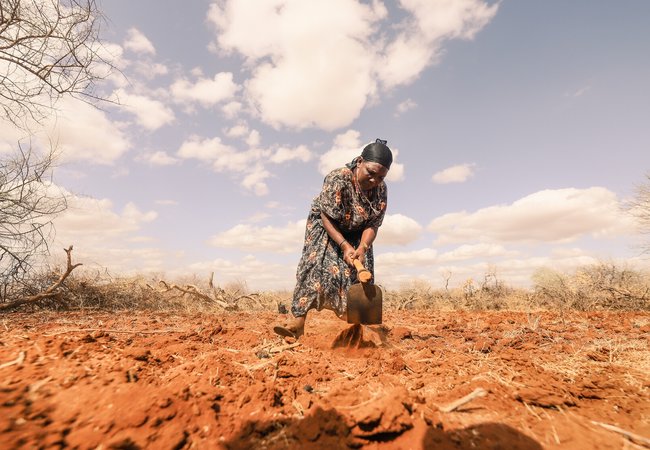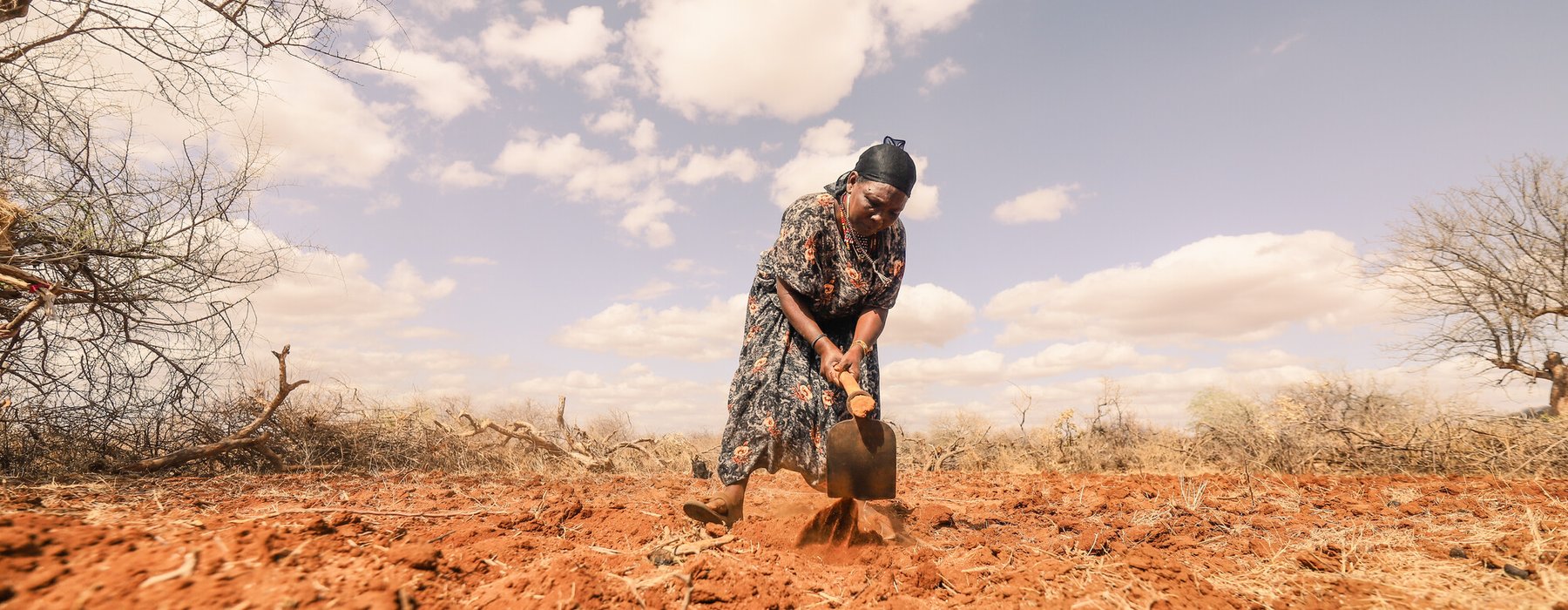- Facts about droughts: The causes and impacts
- Climate change and drought
Forced to leave her home due to one of the worst droughts in decades, Galmo, like thousands of other women, embarked on a long journey in search of water. Image: Mark Wahwai/Oxfam


Facts about droughts: The causes and impacts
As global temperatures rise, droughts are becoming more and more frequent.
What are droughts?
Drought is a lengthy dry spell caused by a prolonged period of no rainfall. During droughts, water becomes scarce or dries up altogether. Drought happens gradually and has disastrous consequences for people, animals and the environment. Droughts occur all over the world, including the UK, and can last for weeks, months or years.
In the UK or North America, long dry summers mean hosepipe bans and parched gardens. In low-income countries, droughts too often lead to displacement, disease and death. As global temperatures rise, droughts are becoming more and more frequent.
Climate change is exacerbating conditions in drought-prone countries, contributing to even hotter and drier weather, and causing droughts to last longer.
Human causes of drought
Scientists agree that human actions are driving climate change and contributing to a greater risk of drought.
Climate change
Our reliance on fossil fuels to power our homes, industry and cars is driving up global temperatures, causing the climate to change. Burning coal, gas and oil produces carbon dioxide and other greenhouse gases. These gases build up in the atmosphere, trapping heat like the glass roof of a greenhouse. This then creates hotter temperatures, which in turn cause water to evaporate quicker. As water evaporates, the surface temperature of the land increases and the earth parches.
UN studies predict that climate change is likely to increase the risk of drought in 129 countries in the next few decades. Low and middle-income countries are most at risk because they don’t have the resources to withstand the devastating impact of droughts. Despite being the least responsible for climate change, people in these countries are suffering its worst effects in the form of more intense and frequent droughts, floods and fires.
Deforestation
The world’s rainforests and woodlands play a vital role in maintaining the earth’s climate.
As the lungs of the earth, trees absorb vast amounts of carbon dioxide, reducing emissions overall and keeping global temperatures down.
Trees also promote rainfall by absorbing water from the soil and releasing moisture into the atmosphere, which then goes on to produce clouds and rain.
Forests are a key defence against drought, but logging and clearing of vast swathes of rainforest for human use and profit continue unchecked.
The Amazon rainforest loses about 10,000 acres every day to this kind of destruction, leading to severe droughts in surrounding areas, and having disastrous consequences for the earth’s climate.
High demand for water
The industries that serve our seemingly endless need for the latest clothing or gadgets are also placing huge pressure on the planet’s water reserves.
The fashion industry is the second biggest consumer of water after agriculture. Every year, it uses around 93 billion cubic metres of water, which is enough to meet the needs of 5 million people.
Fast fashion, luxury goods and the production of other textiles are depleting groundwater in Brazil, Central Asia, India and parts of the USA.
Cotton production uses a lot of water. Making just one pair of jeans takes 7,500 litres of water – around as much you would drink in seven years.
The UN has found that fast fashion accounts for 8% of the world’s greenhouse gas emissions, more than all airplane and shipping emissions combined. And these gases make the planet much hotter. With its huge carbon emissions and near bottomless thirst, the fashion industry is drying out our planet – all because of our constant demand for cheap, trendy clothes.
Agriculture
Farming uses more than 70% of the world’s freshwater, making it the biggest consumer of this precious resource. Not only is it sapping the reserves that are there, but it’s also the biggest cause of pollution of what water is left. Agriculture occupies about half of all land that can be lived on, and is also a leading cause of de-forestation. However you look at it, our hunger for cheap, plentiful food is having a grave impact on the climate and the planet. Food production accounts for more than a quarter of the world’s greenhouse gas emissions – driving global warming and, ultimately, more drought.
Natural causes of drought
Our actions have intensified pre-existing fluctuations in our climate. Weather patterns have been changing naturally for millennia, with drought occurring periodically as a result.
Natural climate patterns
El Niño and La Niña are climate patterns that were noticed by fishers in Peru as early as the 17th century.
They are an important weather system which involves both atmospheric conditions and changing temperatures in the ocean.
El Niño is an unusual warming of water at the surface of the east tropical Pacific Ocean.
Occurring every two to seven years, it causes these warmer waters at the equator to spread further than usual.
This drives up global temperatures during that time.
El Niño usually causes dry spells, including drought conditions, in Southeast Asia, Central Africa and Australia, while causing wetter weather elsewhere.
La Niña is El Niño’s opposite, characterised by an unusual cooling of surface waters in the same area of the Pacific Ocean, and a general decline in global temperatures when it occurs.
The jet stream
The jet stream is a set of strong winds that blow from west to east about 8 to 15km above the earth’s surface. It’s like a river of winds, rising and falling in the earth’s atmosphere, moving snake-like around the earth. Flowing at rates of 129 to 225km per hour, and sometimes reaching more than 400km per hour, these winds occur when hot and cold air meet. The jet stream can push and pull storms across regions, and shapes weather patterns around the world. A slower jet stream can cause hotter, drier weather, which can lead to drought. Human-affected climate change is causing rising global temperatures. This is weakening the jet stream, contributing to more drought conditions.
The impacts of drought
Drought occurs in countries the world over, but it hits people in low-income countries the hardest. They’re responsible for only a tiny fraction of global carbon emissions and therefore global warming, yet they’re shouldering the biggest burden.
The effects are devastating.
With little to no water nearby, people, especially women, must walk long distances to collect it. The water they find may not be clean and this can lead to serious health problems. Without water, crops can’t grow. Animals die. Hunger takes hold. Poverty, disease and death rise.
Extreme drought affects Africa more than any other continent.
People in East Africa are living this nightmare right now.
After five years of failed rainy seasons, they’re facing the worst drought in 40 years. Extreme drought is pushing millions of people here out of their homes and into poverty.
The situation is at crisis point with one person in East Africa dying of hunger every 28 seconds.
What is Oxfam doing to help people affected by drought?
Communities themselves are leading the way in using sustainable methods to weather extreme drought. And Oxfam is working alongside them to expand those efforts. From giving cash transfers to people in urgent need, to providing clean water where sources have dried up, to promoting climate resilient farming practices – we’re supporting communities to grow their way out of the drought crisis.
Support people in East Africa and beyond to get the tools they need to withstand the devastating impact of drought. Take action today.